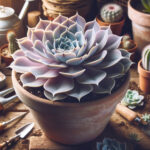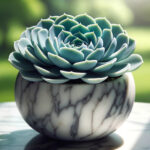Welcome plant lovers! Today, we’re taking an in-depth look at a real gem of the green world – Echeveria ‘Lola’. If you’re not familiar with this succulent superstar, prepare to be utterly enchanted.
A Gem Among Succulents: Echeveria ‘Lola’
Often likened to an opalescent treasure, Echeveria Lola is a stand-out variety of echeveria, a large genus of flowering plants in the succulent family. The Lola variant, with its perfectly shaped rosettes in soft pinks and vibrant greens, has earned its place as a firm favorite among gardeners and houseplant enthusiasts alike.
Origin of Echeveria ‘Lola’
So, where does Echeveria Lola come from, you might be wondering? Its roots, pun intended, trace back to Mexico, home to the majority of echeveria species. But our Lola isn’t just any echeveria: this specific variety is a hybrid, lovingly bred for its unique and appealing aesthetic. How amazing is nature’s capacity for diversity and beauty, right?
Popularity among Gardeners and Plant Enthusiasts
Now onto the question of why Echeveria Lola is so popular, it’s kind of a no-brainer when you think about it! Firstly, Lolas are robust and relatively easy to care for, making them a wonderful choice for both green-thumbed experts and those new to the plant game. Secondly, their intriguing sculptural shape and delicate hues make them one fetching focal point whether in a container garden or nestled among other houseplants on a sunny windowsill. No surprise, then, that the Lola is one succulent that’s hard to keep in stock at nurseries and garden centers nationwide!
Intrigued by the Echeveria Lola? I bet you are! Stay with us as we delve deeper into this charming plant’s care requirements, potential issues, propagation strategies, and answer some of the most frequently asked questions. Let’s go green together!
Get ready, plant lovers − let’s take a crash course on one of the most beloved succulents ardent botany enthusiasts adore: the ethereal Echeveria Lola.
Unmasking the Enigmatic Echeveria Lola
Created by crossing Echeveria Lilacina with Echeveria Derenbergii, the Echeveria Lola is a charming succulent that has captured the hearts of many. Does the name ring a bell? For some, it might be reminding you of the classic song, “Lola” by The Kinks. Believe it or not, this plant and that song have something in common − they both have the power to leave an indelible impression.
Making Headway with Size and Shape
Stepping right into the specifics, the Echeveria Lola typically grows to about four to six inches across, with a height of about six inches when fully mature. Picture a personalized, miniature-sized rosary in your garden − that’s Lola for you. The tightly packed leaves sprout from a central point, unfolding in a spiral, resembling a rose. It’s as if Mother Nature sculpted a living rose out of stone − a perpetual marvel to its beholders.
A Deep Dive into Lola’s Alluring Colors
Speaking of color, the Echeveria Lola doesn’t shy away from putting on a spectaculrar show. Initially sprouting in a strikingly beautiful pearlescent lavender tone, it evolves to display more pinkish hues with better light, making it an instant attention grabber. And let’s not forget, the leaves’ tips are graced with delicate whispers of pink, a perfect finish to its almost ethereal look. Imagine the pastel hues of a summer sunset captured in the compact shape of this succulent. Now, who wouldn’t want to own such an enchanting plant?
Exploring Lola’s General Physical Characteristics
This unique succulent has a combination of physical attributes that gives it an otherworldly aura. On the outside, it is coated with a powdery layer of farina – a natural sunscreen for the plant. And the leaves? They are a stunning spectacle – thick, fleshy, and generously adorned with water-storing tissues, ideal companions during the dry summer months. Just be careful not to overwater – the Echeveria Lola detests water-logged soil.
In conclusion, the Echeveria Lola is more than just a pretty plant. It’s a mesmerizing succulent that embodies resilience wrapped up in a soft, fascinating palette of pastel hues. An absolute showstopper, don’t you think?
Let’s dive into the lovely world of Echeveria Lola, which is like a mesmerizing little pet that does not move or bark! So, if you’re wondering how to cultivate and care for this stunning succulent, you’re in the right place! From lighting requirements to soil type, we’ve got you covered.
1. Let there be Light
Echeveria Lola plants have a lot in common with sunflowers. No, they don’t produce delicious seeds or look alike. Instead, they both love soaking up rays of sunshine! Lola needs bright but indirect light for the best growth and to maintain its lovely colors. Keep your plant near a window that gets a good amount of sunshine, or better yet, let your little green friend enjoy some outdoor weather!
2. H2O – More Important than your Morning Coffee
When it comes to watering an Echeveria Lola, the rule is simple – moderation is key. Just like us humans getting a bit grumpy with either too little or too much coffee, Echeveria Lolas aren’t fans of extreme watering regimes. Overly moist soil can actually cause root rot, while very dry soil will stress the plant. You have to find the balance! The watering schedule can vary depending on the climate you are in. As a safe bet, water your Lola thoroughly once the top inch or so of soil is dry. This method is often called the “soak and dry” method.
3. Soil Type – Lola’s Preferred Ground
Echeveria Lola is not too picky about the type of soil, as long as it’s well-draining. The natural habitat of Lola is rocky terrains, so replicating some of those gritty soil conditions in your pot would make your plant feel at home! You could easily mix some perlite or pebbles into standard potting soil and voila – you have a perfect soil mix.
4. The Temperature Tango
Last but by no means least, let’s take a quick dance around Echeveria Lola’s temperature needs. Lola prefers a mild climate, neither too hot nor too cold. A too chilly environment can cause damage to your plant, while extreme heat could result in sunburn. So, keep your Echeveria Lola in a comfortable room temperature range, ideally between 60 and 80 degrees Fahrenheit.
In summary, cultivating and caring for an Echeveria Lola might seem tricky at first, but once you’ve got the hang of it, it’s pretty straightforward. With good light, sensible watering, well-draining soil, and a comfortable temperature, you and your Lola will be doing a happy plant-parent dance in no time!
Potential Challenges in Growing Echeveria Lola
Our journey to the world of succulents would be incomplete without focusing on some of the potential challenges that you, as a budding or seasoned gardener, might face while growing Echeveria Lola. As lovely and resilient as they may be, Echeveria Lolas are not exempt from battling some typical gardening foes like pests and diseases.
Playing Frenemy With Pests
The first obstacle you might encounter in your Echeveria Lola gardening journey is dealing with succulent pests. Mealybugs, for instance, are a common nemesis. These tiny, cotton-like pests would love nothing more than feasting on your beloved Echeveria Lola. Worst of all, they can be hard to spot until they have caused significant damage.
Take it from me — I’ve seen once-lush Echeveria Lola specimens teetering on the brink of plant demise thanks to these critters. Your best line of defense here is regular inspections of your Echeveria Lola. Catching these pests early can save you a lot of time and your Lola a lot of stress.
Battling Diseases and Rot
Another formidable enemy that your Echeveria Lola might face is fungal diseases, often resulting from overwatering or poor ventilation. Root rot, for instance, is a common issue, particularly with indoor Echeveria Lolas where airflow might be limited.
I’ve had to say goodbye to a few echeveria Lolas that succumbed to the ravages of root rot. I learned the hard way that moderation is key when watering these succulents and ensuring a well-draining soil mix is a must.
Handling Other Plant Parenthood Challenges
Let’s not forget other challenges like dealing with temperature stresses. Echeveria Lola can struggle in excessively hot or cold conditions. They also dislike drastic temperature changes, something that can be particularly tricky for indoor growers with fluctuating room temperatures.
Once, during a bitterly cold winter, my indoor Echeveria Lola wasn’t thrilled about being stuck next to a drafty window and showed its displeasure with droopy, discolored leaves. A quick change of scenery with a stable temperature ensured it bounced right back to its healthy self!
In conclusion, while there undoubtedly are challenges, armed with the right knowledge and a modicum of dedication, you can ensure your Echeveria Lola thrives. Remember – every challenge is an opportunity to learn, adapt, and ultimately, succeed in your gardening journey.
Propagating Echeveria Lola isn’t just for professional horticulturists – it’s a delightfully exciting activity for any plant lover! You don’t need a green thumb, just a hearty dose of patience and perseverance. Let’s delve into the art of propagation and see how your Echeveria Lola can produce multiple little plant babies.
Propagating Echeveria Lola through Leaf Cuttings
Ever seen a lizard’s tail regrow? Propagation through leaf cuttings is a similar process, but slow as a snail race. Choose a healthy, mature leaf from a Lola, gently twist it off ensuring the break is clean. Not as James Bond with a martini, but it still needs a delicate touch. Leave it for a few days at room temperature to allow the cut end to callus over (a healing process for plants, not a medical condition).
Once the leaf has callused, place it on well-draining soil. Resist rushing things, keep the faith, and in a few weeks, you’ll see tiny Lola babies sprouting from the mother leaf. It’s like waiting for kettle water to boil, but the result is worth every second.
Dividing Potted Echeveria Lola Clumps
For those looking for a fast track to increase their Echeveria collection, division is your best friend. Remember splitting up a pie at a family dinner? You’ll do the same here with your mature Echeveria Lola cluster. In the growing season, gently break the Lola clump apart while repotting, taking care to keep each segment’s roots intact. More pot pies for everyone!
Care for Divided Echeveria Lola
Don’t throw a party just yet. Distance our freshly-divided plants from direct sunlight for a couple of days, then gradually reintroduce them. This gives the Lola a chance to adapt to their new found independence. Like college freshers, they need time to settle into the new normal.
Seeds: A Labor of Love
Lastly, you can propagate Echeveria Lola through seeds. This method is a slow dance, taking an ample amount of time before you see any action. But patience, my friends, is the key to this dance floor. Your reward? Watching the birth and growth of a fresh new Lola from the very beginning. A bit like nurturing a baby bird to fly…
So plant enthusiasts, now that we know the methods of propagating Echeveria Lola, why wait? Let’s get our hands dirty!
Echeveria Lola’s Role in Home Decor
First things first, let’s dive straight into the aesthetics. Wouldn’t you agree that there’s something intriguing about the soft lavender hues of the Echeveria Lola merging with its opalescent sheen? Akin to a pearl nestled amidst a sea of green foliage, this succulent can effortlessly upgrade your home decor game.
Enhancing Aesthetics with Echeveria Lola
Integrating Echeveria Lola within your living spaces can be more impactful than you might think. Picture this – a sunny day, natural light streaming through paneled windows illuminating the Lola with its rosy blush. Très Chic! It effortlessly turns a bare corner or mundane coffee table into an ethereal spectacle.
Pro-tip: Place these succulents in rooms with a white or neutral color palette to amplify their soft pastel tones. You’ll find that your room has magically transformed, enhancing the overall aesthetics!
Life in the Kitchen
Now, remember that empty windowsill over your kitchen sink? Yes, the one right under the sunbeam that you’ve been meaning to fill with something. An Echeveria Lola would be perfect there! Its natural luminosity subtly counteracts the stainless-steel kitchenware, balancing out the overall visual temperament. Plus, it gets all the sunlight it needs.
Fit for Tiny Corners
For those unassuming corners in the house that you’ve been scratching your heads over? Echeveria Lola to the rescue! Tiny ceramic pots with this charming succulent are ideal for fitting into smaller spaces. The contrasting dimensions make the Lola stand out and elevate the look-and-feel of the entire area. After all, who said only large decor pieces can be statement-makers?
Echeveria Lola’s Allure: Night & Day
Another fantastic aspect of the Echeveria Lola is that its visual charm isn’t limited to daylight hours. Under night lamps or fairy lights, the succulent’s waxy coating disperses light in a mesmerizing spectacle of hues. The transition from day to night decor has truly never been smoother!
To sum it up, whether you’re breathing life into a drab corner, creating a Zen space, or adding a green note to your kitchen, the Echeveria Lola makes for an exquisite addition. It’s not just a plant; it’s a low-maintenance piece of living art, ready to enhance aesthetics and bring a unique, evergreen charm to your home!
Frequently Asked Questions
With its enchanting rosettes and captivating iridescence, it’s little wonder why Echeveria ‘Lola’ captivates so many green thumbs. But incessantly asked queries linger in the air, anxious for answers – so let’s dive in, shall we?
What care does the Echeveria Lola need?
Well, you’re in luck! Echeveria ‘Lola’ is a forgiving plant, perfect for beginners. It needs a fair share of sunlight, preferably a few hours of direct sun each day. As for watering, a deep soak every few weeks should suffice. Remember, less is more when it comes to water, so make sure the soil dries out completely between each watering session.
How can I propagate my Echeveria ‘Lola’?
Propagating your Lola isn’t as complicated as it might sound. You can opt for two methods – leaf cutting or through offsets. For the leaf cutting method, twist off a healthy leaf from the base, let it callus over for a few days, and then place on well-draining soil. The offset method, on the other hand, involves removing a fully formed miniature rosette and replanting it. With proper care, these propagations should root within a few weeks.
What common issues do gardeners face with the Echeveria Lola?
Like any other plant, the Echeveria ‘Lola’ has its share of issues. The most common problem is overwatering, which leads to root rot – a surefire Lola killer. To prevent this, ensure your plant has proper drainage and that you’re not giving it too much water. Pests like mealybugs or aphids can also be a nuisance, but a quick wipe down with an insecticidal soap usually does the trick. Lastly, Lola might get a little sunburnt if exposed to midday sun, so it’s best to provide filtered afternoon light.
Why is my Echeveria ‘Lola’ turning yellow?
Yellowing or softening leaves on your Echeveria ‘Lola’ are signs of overwatering. This plant prefers a dry environment – think desert conditions. If overwatered, it will let you know by changing its color to a sickly yellow. In such cases, reassess your watering schedule and ensure your plant has enough light to dry up potential excess water.
Considering these delightful queries and answers, it’s evident that while the Echeveria ‘Lola’ might be a diva, she’s worth all the trouble. So gear up, gardening enthusiast, as this plant promises a rewarding and vibrant journey.



